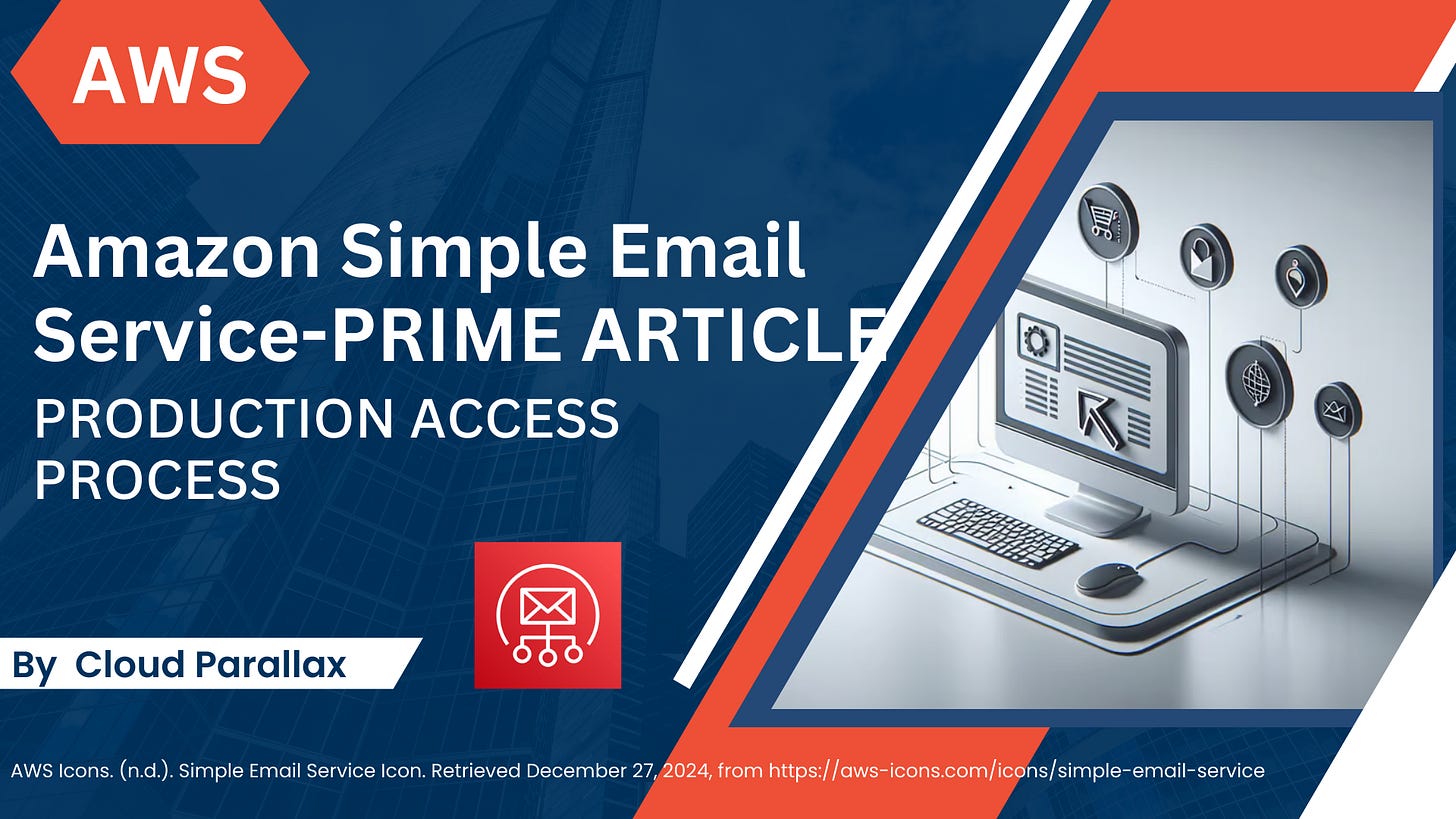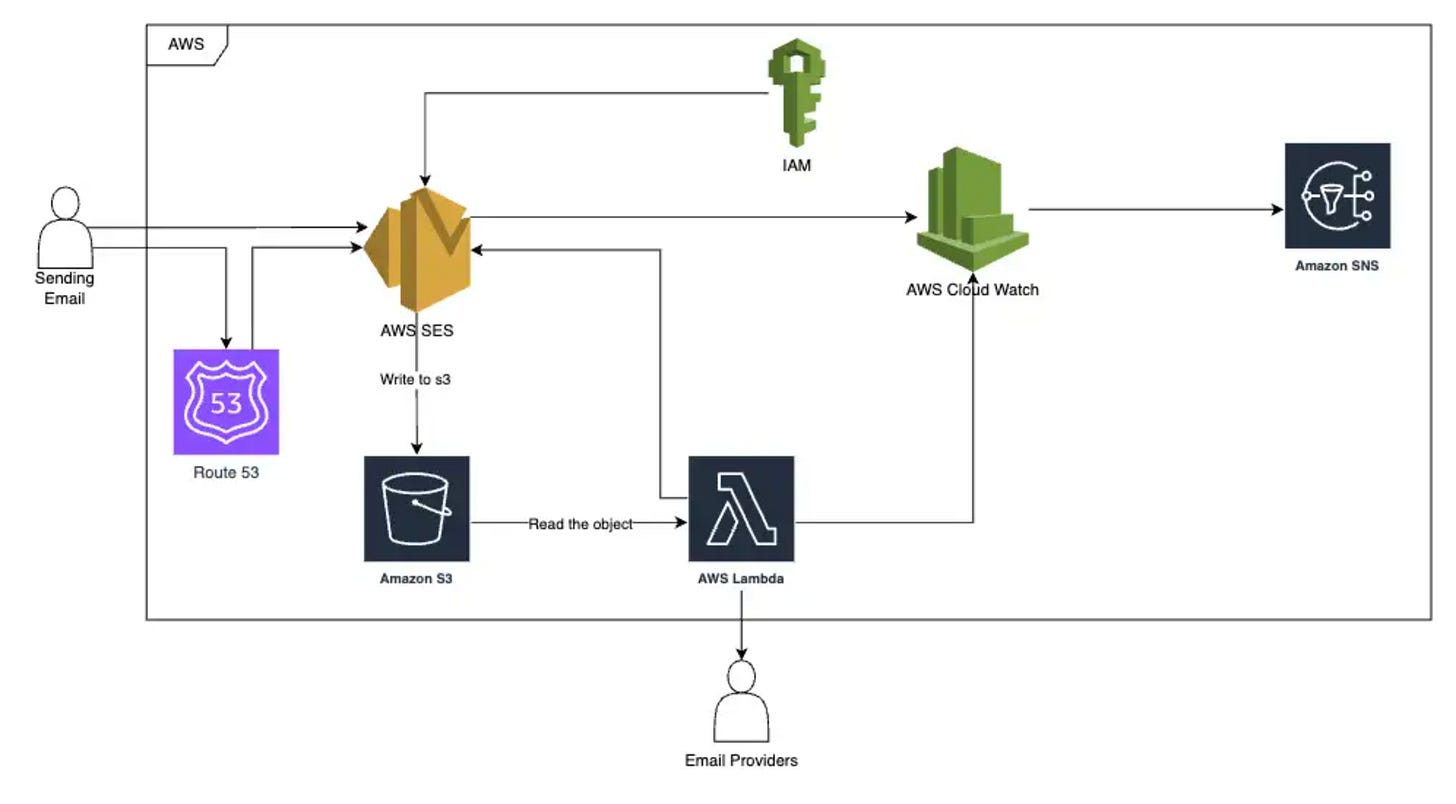AWS SES - PRIME ARTICLE - PRODUCTION ACCESS PROCESS
Dayanantha Shanmugaradnam
Introduction to AWS SES Production Access
Amazon Simple Email Service (SES) requires specific steps to move from the sandbox to the production environment. This article details the technical process and requirements for obtaining production access.
Prerequisites
AWS Account with administrative access
Valid domain ownership
Demonstrated compliance with AWS sending requirements
Low bounce and complaint rates during sandbox testing
Technical Steps for Production Access
1. Domain Verification
Before requesting production access, ensure your domain is verified through:
DNS TXT record verification
DKIM setup with three CNAME records
SPF record implementation
2. Authentication Methods
{
"DkimAttributes": {
"example.com": {
"DkimEnabled": true,
"DkimVerificationStatus": "Success",
"DkimTokens": [
"token1._domainkey",
"token2._domainkey",
"token3._domainkey"
]
}
}
}
3. Production Access Request Process
The AWS SES production access request process is your gateway to sending emails at scale. It's designed to ensure responsible email practices and maintain a high deliverability rate for all SES users. Here's a breakdown of the process:
1. Accessing the Request Form
SES Console: Log in to the AWS Management Console and navigate to the Amazon SES service.
Account Dashboard: On the SES dashboard, you'll typically find a prominent notification or section indicating your sandbox status.
Request Production Access: Click on the provided button or link (often labeled "Request Production Access") to initiate the process.
2. Providing Account Information
Website URL: Enter the URL of your website (if applicable) to help AWS understand your business and email context.
Email Type: Select the primary type of emails you'll be sending:
Transactional: Order confirmations, password resets, account notifications.
Marketing: Promotional emails, newsletters, product announcements.
3. Describing Your Use Case
Detailed Description: Provide a clear and concise explanation of how you intend to use SES.
Be specific about the types of emails you send and their purpose.
Example: "We send weekly newsletters to subscribers who have opted in through our website. We also send transactional emails like order confirmations and shipping updates."
4. Estimating Sending Volume
Daily/Weekly Volume: Provide realistic estimates of your anticipated daily and weekly email sending volume.
Supporting Data: If possible, back up your estimates with data from previous email campaigns or projections based on your business growth.
5. Explaining List Acquisition
Methods: Describe how you obtain your email lists:
Opt-in forms: Website forms, signup pages, etc.
Purchased lists: Clearly state if you use purchased lists and ensure they comply with SES guidelines and anti-spam laws.
Other sources: Explain any other methods you use to acquire email addresses.
6. Detailing Bounce and Complaint Handling
Bounce Processing: Explain how you handle bounced emails:
Automated removal: Describe any automated processes for removing invalid addresses from your list.
Manual review: Explain how you investigate and address bounces that might indicate deliverability issues.
Complaint Management: Outline your process for managing spam complaints:
Unsubscribe process: Describe how recipients can unsubscribe from your emails.
Complaint investigation: Explain how you investigate complaints to identify potential problems with your email content or sending practices.
7. Mail Flow Description (Optional)
Technical Details: You might be asked to provide details about your email sending architecture:
SMTP Interface: If you use SMTP to send emails, specify your setup.
SES API: If you use the SES API, describe your integration and any custom solutions you've implemented.
8. Submitting the Request
Review: Double-check all the information you've provided for accuracy and completeness.
Submission: Submit your request and wait for AWS to review it.
Tips for a Successful Request
Be thorough and accurate: Provide detailed and honest answers to all questions.
Demonstrate responsible practices: Show that you prioritize a good sender reputation and follow email best practices.
Proofread your request: Ensure your request is free of grammatical errors and typos.
Be patient: The review process might take some time.
4. Technical Requirements
Ensure implementation of:
Proper handling of bounces and complaints through SNS notifications
Implementation of feedback loops
Monitoring system for tracking metrics
5. Code Implementation Example
import boto3
def setup_ses_notifications():
ses = boto3.client('ses')
sns = boto3.client('sns')
# Create SNS topics for bounces and complaints
bounce_topic = sns.create_topic(Name='ses-bounces')
complaint_topic = sns.create_topic(Name='ses-complaints')
# Configure SES feedback notification
ses.set_identity_notification_topic(
Identity='your-domain.com',
NotificationType='Bounce',
SnsTopic=bounce_topic['TopicArn']
)
ses.set_identity_notification_topic(
Identity='your-domain.com',
NotificationType='Complaint',
SnsTopic=complaint_topic['TopicArn']
)
Best Practices
Rate Monitoring: Implement CloudWatch metrics for tracking sending rates
Error Handling: Develop robust error-handling mechanisms
Quality Control: Maintain bounce rate below 5% and complaint rate below 0.1%
Documentation: Maintain detailed logs of all email activities
Production Limits
Metric Initial Limit Maximum Limit Daily Sending Quota 50,000 Millions (with approval) Sending Rate 14 emails/second Customizable Maximum Message Size 10 MB 10 MB
Monitoring Setup
Monitoring is a critical aspect of maintaining a healthy sender reputation and ensuring optimal email deliverability with AWS SES.
1. Key Metrics to Monitor
Deliverability: Track the percentage of emails successfully delivered to recipients' inboxes.
Bounce Rate: Monitor the percentage of emails that bounced, categorized into hard bounces (permanent failures) and soft bounces (temporary issues).
Complaint Rate: Keep a close eye on the percentage of recipients who mark your emails as spam.
Open Rate: Track the percentage of recipients who open your emails.
Click-Through Rate (CTR): Monitor the percentage of recipients who click on links within your emails.
Spam Trap Hits: Be aware of any instances where your emails land in spam traps, which are email addresses used to identify spammers.
Sending Reputation Metrics: Monitor your sender score and reputation metrics from various providers to gauge your overall sender health.
2. Tools and Techniques
Amazon CloudWatch: Utilize CloudWatch to monitor SES metrics like sent emails, deliveries, bounces, complaints, and rejections. Set up alarms to receive notifications for unusual spikes or drops in these metrics.
SES Sending Statistics: Regularly review the sending statistics provided in the SES console to understand your sending patterns and identify potential issues.
Feedback Loops (FBLs): Set up feedback loops with major ISPs (e.g., Gmail, Yahoo, AOL) to receive notifications when recipients mark your emails as spam. This allows you to promptly remove complainants from your list.
Email Deliverability Monitoring Services: Consider using third-party email deliverability monitoring services that provide detailed insights into your sender reputation, blacklist status, and inbox placement rates.
Dedicated IP Monitoring: If you're using dedicated IPs, monitor their reputation and blacklist status using tools like Sender Score and BarracudaCentral.
CloudWatch:
Metrics:
- Name: Delivery
Namespace: AWS/SES
Dimensions:
- Name: Type
Value: Send
- Name: Bounce
Namespace: AWS/SES
Dimensions:
- Name: Type
Value: Bounce
- Name: Complaint
Namespace: AWS/SES
Dimensions:
- Name: Type
Value: Complaint
Troubleshooting Common Issues
Troubleshooting AWS SES issues requires a systematic approach to identify the root cause and implement the right solution. Here's a breakdown of how to troubleshoot the common issues we discussed earlier:
1. Identity Verification Issues
DNS Configuration Errors:
Use DNS lookup tools: (e.g.,
nslookup,dig) to verify that your DNS records are correctly propagated.Check record values: Ensure the TXT or CNAME record values exactly match those provided by SES.
Review TTL: Check the Time-To-Live (TTL) value for your DNS records. It might take some time for changes to propagate.
Email Verification Delays:
Check spam/junk folders: Thoroughly check all folders in the recipient inbox.
Whitelist SES addresses: Add
no-reply@verificationemail.amazonses.comto your email client's safe sender list.Resend verification email: If the email doesn't arrive, use the SES console to resend the verification email.
2. IP Warm-up Challenges
Sudden Spikes in Volume:
Reduce sending volume: If you observe a sudden increase in bounces or complaints, immediately reduce your sending volume.
Review sending schedule: Ensure you're gradually increasing volume according to a planned schedule.
High Bounce Rates:
Validate email addresses: Use an email validation service to identify and remove invalid email addresses from your list.
Implement a double opt-in process: Require users to confirm their email address before adding them to your list.
Complaint Rate Spikes:
Review email content: Ensure your content is relevant, engaging, and aligns with recipient expectations.
Check sending frequency: Avoid sending emails too frequently, which can lead to recipient fatigue and complaints.
Provide clear unsubscribe options: Make it easy for recipients to unsubscribe from your emails.
3. Production Access Request Denial
Insufficient Information:
Provide detailed answers: In your production access request, provide comprehensive and accurate information for each field.
Explain your use case clearly: Clearly articulate how you use SES and the types of emails you send.
Justify your sending volume: Provide data or estimations to support your requested sending volume.
Lack of Warm-up:
Warm up your IP: Follow the warm-up process diligently, gradually increasing sending volume over time.
Demonstrate responsible sending: Show a history of low bounce and complaint rates in your request.
Unclear Bounce/Complaint Handling:
Document your processes: Describe your procedures for removing invalid addresses and handling complaints.
Highlight automated processes: If you have automated bounce and complaint handling, explain how they work.
4. Email Deliverability Problems
Spam Filters:
Analyze email content: Use a spam checker tool to identify potential spam triggers in your emails.
Avoid spammy language: Refrain from using excessive capitalization, exclamation marks, or misleading subject lines.
Maintain a good text-to-image ratio: Include a balanced amount of text and images in your emails.
Blacklisting:
Monitor blacklists regularly: Use blacklist monitoring services to check if your IP address is listed.
Contact blacklist operators: If your IP is blacklisted, follow the instructions provided by the blacklist operator to get delisted.
Content Issues:
Optimize email formatting: Use clean HTML code and avoid excessive styling.
Compress images: Reduce the size of images to improve email load times.
Use a preheader: Provide a concise summary of your email content in the preheader.
5. Technical Challenges
SMTP Configuration:
Verify SMTP credentials: Double-check your SMTP username and password.
Check server address and port: Ensure you're using the correct SMTP server address and port for your region.
Test SMTP connection: Use a tool like
telnetto test the SMTP connection.
API Integration Issues:
Review API documentation: Refer to the SES API documentation for correct usage and error handling.
Check for code errors: Debug your code to identify any errors in API calls or data formatting.
Use AWS SDKs: Utilize official AWS SDKs for your programming language to simplify API integration.
By systematically investigating these issues, you can effectively troubleshoot AWS SES problems and ensure reliable email delivery for your applications. Remember to leverage AWS resources like documentation, support forums, and support cases for further assistance.
Maintenance and Monitoring
Regular maintenance tasks include:
Daily monitoring of bounce and complaint rates
Regular review of CloudWatch metrics
Periodic updates to sending infrastructure
Regular cleaning of recipient lists
<aside> Remember: Maintaining good sending practices is crucial for keeping production access. AWS can revoke access if sending metrics consistently fall below acceptable thresholds.
</aside>
Conclusion
Gaining production access to AWS SES is a crucial step for any individual or business looking to send emails at scale. While the process may seem daunting at first, with careful planning and execution, it is entirely achievable. By understanding the requirements, meticulously verifying identities, diligently warming up your IP address, and providing detailed information in your request, you can increase your chances of a successful approval.
Remember that maintaining a healthy sender reputation is an ongoing commitment. Continuously monitor your sending metrics, adhere to email best practices, and promptly address any deliverability issues that may arise. By doing so, you can unlock the full potential of AWS SES, ensuring your emails reach your intended audience and contribute to the success of your communication strategies.
Ultimately, the journey to AWS SES production access is an investment in your email sending capabilities. By prioritizing responsible email practices and adhering to AWS guidelines, you can establish a solid foundation for reliable, high-volume email delivery and achieve your communication goals.

